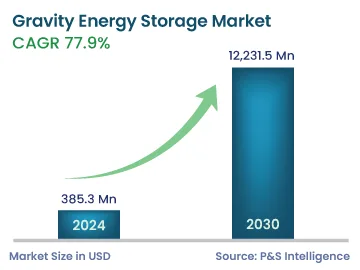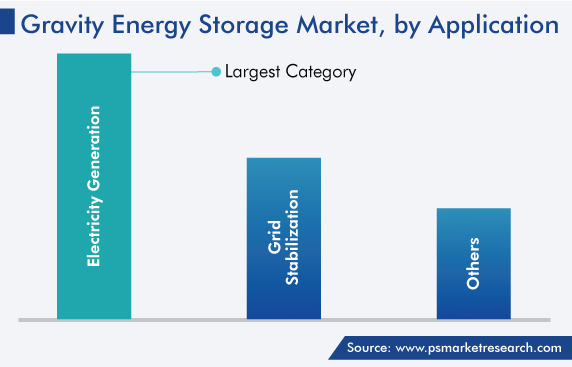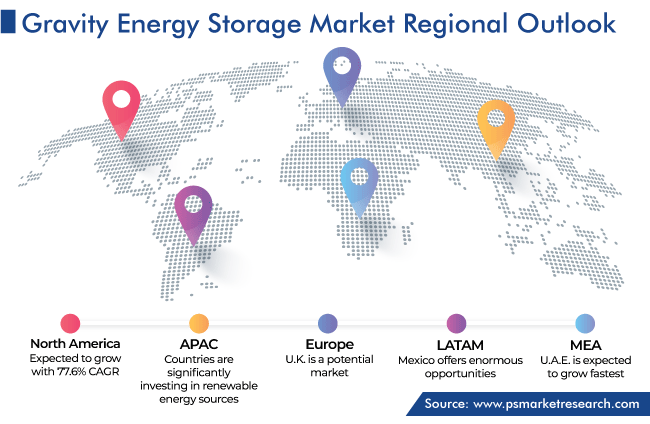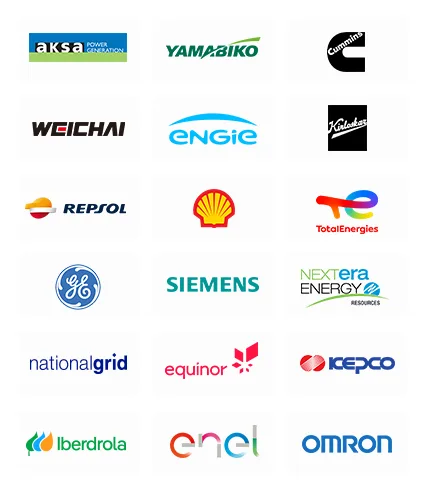Market Statistics
| Study Period | 2019 - 2030 |
| 2024 Market Size | 385.3 Million |
| 2030 Forecast | 12,231.5 Million |
| Growth Rate(CAGR) | 77.9% |
| Largest Region | North America |
| Fastest Growing Region | Asia-Pacific |
| Nature of the Market | Consolidated |
Report Code: 12790
Get a Comprehensive Overview of the Gravity Energy Storage Market Report Prepared by P&S Intelligence, Segmented by Type (Hydroelectric Dams, Pumped Hydro Storage), Application (Electricity Generation, Grid Stabilization), End Use (Residential, Commercial, Industrial, Utilities), and Geographic Regions. This Report Provides Insights From 2019 to 2030.
| Study Period | 2019 - 2030 |
| 2024 Market Size | 385.3 Million |
| 2030 Forecast | 12,231.5 Million |
| Growth Rate(CAGR) | 77.9% |
| Largest Region | North America |
| Fastest Growing Region | Asia-Pacific |
| Nature of the Market | Consolidated |

Explore the market potential with our data-driven report
The gravity energy storage market is set to generate revenue of USD 385.3 million by the end of 2024, which is expected to witness a CAGR of 77.9% during the forecast period (2024–2030), reaching USD 12,231.5 million by 2030. This will be due to the strong focus on renewable energy resources, adoption of electric vehicles, demand for grid stability, and increase in the cost of electricity.
The government initiatives to encourage the adoption of such systems are also an important factor driving the market. Subsidies and incentives are helping investors and developers by making the technology more economically viable. Specific policies include standards for the integration of renewable energy and support mechanisms for technologies such as gravity-based power storage systems.
The consumption of energy has been increasing forever, which has created a space for the gravitational energy storage market to grow at a rather high rate. There are various reasons behind the rising energy consumption, including population growth, advancements in technology, growing transportation needs, urbanization, and industrialization.
Gravity energy storage systems can be used in combination with other renewable energy sources, offering a reliable source of power in case the wind does not blow or the sun does not shine. The stored electricity is released when it is needed, such as in times of peak demand. In developing countries, the rapid industrialization and urbanization have enhanced the requirement for energy storage. These systems are long-lasting and low-cost, possess a high energy density, and present an effective solution for storing renewable energy.
These two requirements have become important amidst the rapidly increasing electricity demand. Moreover, by swiftly releasing energy when required, they can help the grid better withstand extreme weather events and mitigate blackouts and complete failures. The worth of such systems has started becoming even more evident since the world is now headed toward a sustainable future, where renewable power sources will take centerstage.
Electric vehicles also play an important role in driving the market forward. As people are much more aware of the environmental impact of fossil-fuel-powered vehicles, the demand for electric vehicles is increasing. Many recognized and emerging firms are spending a huge amount on EV production and research and development, with governments going all out on regulatory and financial support. Apart from being encouraged by government support, people are switching to them because it is cheaper to charge vehicle batteries than purchasing gasoline and diesel. Therefore, the market for charging infrastructure is growing rapidly due to the rising installation of charging stations to cater to the increasing number of electric vehicles.
However, the cost of electricity is high nowadays; so, it has become important to reduce the price. This can be done by storing energy during off-peak hours and then releasing it when required. Apart from helping in this aspect, gravity energy storage also helps in the prediction of energy costs and allows for the usage and storage of energy based on consumption patterns and price forecasts. Large energy consumers such as manufacturing companies, commercial entities, and transportation firms, often require a significant amount of energy. Therefore, they are now adopting this technology to manage their electricity budgets efficiently.
The pumped hydro storage category is expected to witness a growth rate of 77.7% during 2024–2030. This approach is preferred due to its capability to store and release an enormous quantity of electricity efficiently. According to the International Hydropower Association (IHA), PHS accounts for 94% of the installed global energy storage capacity and these pumps store up to 9,000 GWh of electricity. This technology reliably balances the energy supply and demand and ensures the stability of the grid.
In case renewable sources, such as solar and wind, produce more electricity than required, water is pumped from a lower reservoir to an upper reservoir with the help of this additional energy. If there is a reduction in renewable generation or if electricity requirement increases, then electricity is generated through the stored water much like in a conventional dam. This helps in meeting the demand without siphoning from power plants that run on fossil fuels.
Whenever the power demand peaks, these installations prove efficient in providing energy. Since they can rapidly respond to the increased demand, they can reduce the dependence on Peaker plants and imported fuels to meet the energy requirements for electricity generation, heating, and industrial purposes. This ultimately helps in cost savings for consumers and utilities.
The key advantage with PHS is that it can store energy for a long time. This is important to maintain the stability of the grid and ensure a continuous supply of power, specifically in regions that witness variable energy generation. Batteries and other energy storage technologies are enhanced with the use of these systems, since their integration with batteries contributes to improving their scalability, efficiency, and grid stability. Thus, PHS has a huge role in assisting in the efficient storage, conversion, and utilization of energy.
Moreover, these installations have a minimal environmental impact, unlike power generation from fossil fuels, primarily due to the negligible greenhouse gas emissions. In many regions, incentives and regulatory policies boost the deployment of energy storage solutions, including PHS, by making them more economical to implement and operate.
In the application segment, the electricity generation category is the largest, because PHS systems are widely used for electricity generation. This is itself due to their high energy storage capabilities and capacity to generate electricity when there is high demand or enough energy is not available from other sources.
These systems are highly efficient at balancing the electricity grid by providing rapid responses when the power demand surges. It is a proven and well-established technology for large-scale energy storage and electricity generation. Hence, its efficiency, reliability, and long operational history have made it a popular choice for electricity generation.

Drive strategic growth with comprehensive market analysis
Currently, North America is holding the largest gravity energy storage market share, followed by Europe and APAC, due to the initiation of numerous gravity energy storage projects, technological readiness, high demand, and supportive policies. Additionally, the adoption of these approaches is rising due to an increase in the number of electric vehicles and rise in the awareness of the benefits of renewable energy sources.
Further, both the U.S. and Canada have been making significant investments in energy storage projects. They are also implementing regulations to enhance the adoption of clean energy technologies, such as fossil fuel usage reduction mandates, research and development initiatives, and financial incentives. This region had, earlier, seen the extensive adoption of lithium-ion batteries both for behind-the-meter installations and grid-scale usage, since they provide fast responses. However, since they can hold the electrical charges for a short duration, gravity energy storage systems, especially pumped hydro, are being used to supplement Li-ion batteries.

APAC is expected to grow at the highest CAGR, of 80.4%, from 2024 to 2030 because of a swiftly expanding renewable energy sector, especially in India, Japan, and China. This is itself because these countries have been significantly investing in renewable energy sources, such as solar and wind. A strong market potential has been created by the integration of these intermittent energy sources with storage solutions to ensure a reliable power supply and cope with the variability in generation.
Essentially, in the APAC region, many countries are going through an energy transition to eliminate the need for fossil fuels and use more of clean energy technologies. Storage technologies play a vital role here by enabling the incorporation of renewable sources and improving the stability of the grid. Energy demand continues to skyrocket in the region due to economic growth, rapid electrification, and urbanization. Hence, gravity energy storage systems are being deployed to meet this rising demand economically and accurately.
Several governments in the APAC region have also introduced policies and attractive incentives, in the form of feed-in tariffs and subsidies, to boost the adoption of electricity storage technologies. Further, the region is a key manufacturer of energy storage systems and their components. Regional nations are also ahead in terms of innovation and research, with many companies and research institutions focused on the field of energy storage. This would lead to the emergence of more-efficient technologies to store electricity and release it swiftly to the grid, to meet the power demand surge and prevent grid failures.
This fully customizable report gives a detailed analysis of the gravity energy storage market, based on all the relevant segments and geographies.
Based on Type
Based on Application
Based on End Use
Geographical Analysis
The revenue of the market for gravity energy storage solutions has been estimated at USD 385.3 million in 2024.
The gravity energy storage industry will witness 77.9% CAGR till 2030.
The market for gravity energy storage solutions is driven by the rising electricity demand and environmental concerns.
The integration of gravity energy storage with conventional renewable sources is trending in the gravity energy storage industry.
North America is the largest market for gravity energy storage solutions, and APAC is the fastest-growing.
Want a report tailored exactly to your business need?
Request CustomizationLeading companies across industries trust us to deliver data-driven insights and innovative solutions for their most critical decisions. From data-driven strategies to actionable insights, we empower the decision-makers who shape industries and define the future. From Fortune 500 companies to innovative startups, we are proud to partner with organisations that drive progress in their industries.


Working with P&S Intelligence and their team was an absolute pleasure – their awareness of timelines and commitment to value greatly contributed to our project's success. Eagerly anticipating future collaborations.
McKinsey & Company
IndiaOur insights into the minutest levels of the markets, including the latest trends and competitive landscape, give you all the answers you need to take your business to new heights
We take a cautious approach to protecting your personal and confidential information. Trust is the strongest bond that connects us and our clients, and trust we build by complying with all international and domestic data protection and privacy laws
Customize the Report to Align with Your Business Objectives
Request the Free Sample Pages